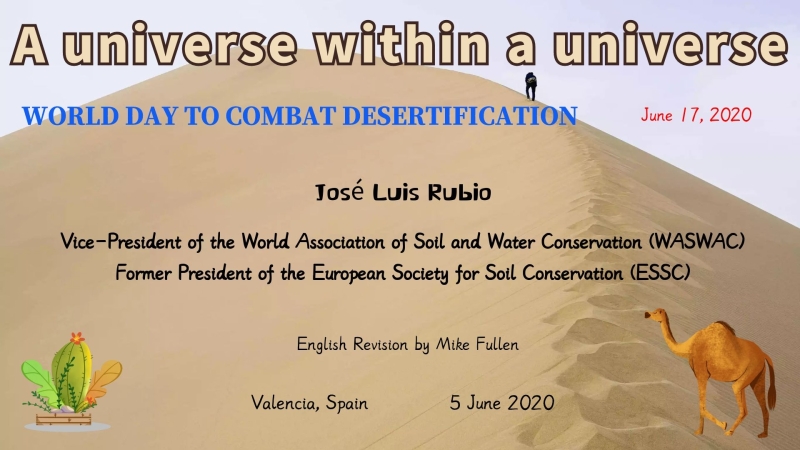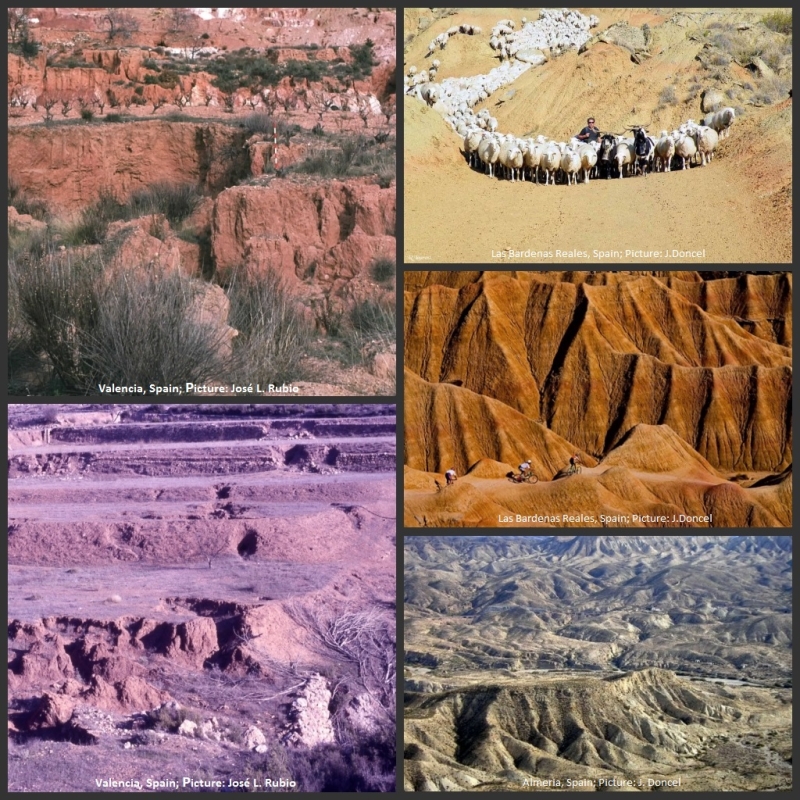
Human beings have always felt the attraction of discovering and
exploring new worlds. For decades, exploration of remote and exotic places on
Earth captured the attention of generations. Today, exploration of the cosmos
remains a powerful focus. But humans, in their eagerness to look far, forgot to
look close.
About 400 million years ago, in the Silurian period, plants ventured
to colonize the emerged lands. With them, a transformation of profound
implications began on the surface of the planet. The desolate landscapes of
rocky fragments and lifeless mineral formations of those geological times began
to transform. Beneath its surface, the creation of a vast organism began, the
fruit of life and creator of life, which gradually began to spread and
interconnect the entire surface of the planet. In the superficial layer of the
Earth, a kind of internal and hidden matrix began to form that was colonizing
and changing the physiognomy of the planet forever. Over millions of years, the
active collaboration between the mineral world, atmospheric forces, plants,
microorganisms and animals created a living organism in which everyone
participated.
A frontier of connection between the mineral and organic world was
established in which its components contributed by exchanging information, food
and energy. Something mobilized the common work of infinite species of
microorganisms, fungi, lichens, algae, plants and animals. In this gigantic
hidden organism everything was interconnected and working with mill metric
precision in unperturbed cycles that have been tirelessly repeated since the
beginning of terrestrial life and whose secret codes we barely understand.
Well, this living organism that embraces, interconnects and gives
life to the planet is called the soil. It is a universe within another
universe. A universe that we do not see but that is there and that is as
unknown as it is essential for the continuity of life on the planet. But it is
as everyday and familiar as it is ignored. Regardless of our indifference,
their activity never stops. Soil is always tirelessly busy and bustling with
activity with infinite chemical transformations, fights between organisms,
biochemical battles, conflicts over available resources and collaboration and
cooperation between very different species. All this occurs under a mandate
that has not been revealed to us, unstoppable and without us realizing it,
under our feet.
This hidden universe is interconnected throughout the land emerged
in networks of fungal mycelia, roots, mycorrhizae, humus macromolecules,
chemical transmitters, and electrochemical signals, which resemble a neural
network.
Its design is brilliantly simple and functional. Weathered rock
fragments provide the anchorage and mechanical support for plant growth. But it
is not just physical roots; a microcosm is created on the border between the
mineral and organic world through fascinating transformations of living tissues
that unite clay particles with humic molecules. A structure, part mineral and
part organic, is created, which ensures the vital functions of the soil. It
enables plant roots to absorb moisture retained in the micropores, that the
plants acquire the nutrients from the soil solution, that it maintains its
stability and resilience to natural and anthropogenic impacts and that it can
provide benefits and ecosystem services to nature in general and to human
beings in particular.
The roots, the humic compounds, the micropores, the mineral elements
and the microorganisms, are like the modules of a fabulous biological reactor
that is the basis for the continuity of life on the planet. This reactor
recycles biological compounds and connects all the biomes on earth, becoming a
great organism of enormous dimensions that permanently renews the basic
elements of life.
The planet's surface has given rise to very different types of soils
due to its climatic and geological variations. Thus, we have soils of tundra,
taiga, steppes, savannahs, temperate forests, jungles, soils of humid zones,
semi-arid soils and even desert soils. Each of them has different
characteristics and properties, to which different types of plants adapt to
create the basis of the planet's biodiversity. In fact, the soil constitutes
the richest zone of biodiversity on Earth. In one gram of soil there can be
more microorganisms than drops of water in the Mediterranean Sea!
The underground universe that represents the ground also has the
power to influence transcendental aspects that occur on the planet's surface.
Among others, these include food production, territorial stability and
resilience, freshwater regulation, climate regulation, chemical composition of
the atmosphere and biodiversity. A separate chapter would include the cultural,
affective and psychological aspects linked to human perception of the
environment and the landscape, at the root of which is the soil.
However, and also occurring without receiving the necessary
attention, this natural component essential for the functioning of the planet,
is currently seriously threatened. Probably one of the most serious
consequences of the global warming trend is the impact on desertification and
soil degradation processes of the planet's arid zones and, in turn, the
feedback of these processes on climate change. The arid and semi-arid zones of
the planet cover approximately 44% of the Earth’s land surface and in them live
about 2500 million people, many of them in precarious subsistence conditions.
We find a perverse spiral that affects the stability, functionality and
productivity of almost half the planet, and involves environmental security
problems (reduced harvests, famines, social and political instability, forced
migration, conflicts and wars) and significant damage and socioeconomic consequences.
These are all due to the disruption of the buffering role of the soil in the
face of extreme climatic phenomena (droughts, torrential rains, floods,
landslides, forest fires and heat-waves).
The natural heritage accumulated over millions of years that shapes
the identity, the support of the landscape and the means of production of 90%
of the food we consume, is in danger, without us being aware of it. Soil is a
living memory of Earth's history. He has been the faithful companion of human
society who keeps the memories of the human adventure on the planet. Today, 17
June, the United Nations reminds us of our age-old connection to the Earth and
our responsibility to present and future generations. It is time to improve our
perception and accelerate solutions. It will cost us
dearly if we don't!

Want to know more about Desertification? (reference from United Nations
website https://www.un.org/en/observances/desertification-day/background)
Desertification is a phenomenon that ranks among the greatest
environmental challenges of our time. As one of global issues, desertification
is with serious implications worldwide for biodiversity, eco-safety, poverty
eradication, socio-economic stability and sustainable development.
The issue of desertification is not new though — it played a
significant role in human history, contributing to the collapse of several
large empires, and the displacement of local populations. But today, the pace
of arable land degradation is estimated at 30 to 35 times the historical rate.
Some two billion people depend on ecosystems in dry land areas, 90% of
whom live in developing countries. A downward spiral is created in many
underdeveloped countries, where overpopulation causes pressure to exploit
drylands for farming. These marginally productive regions are overgrazed, the
land is exhausted and groundwater is overdrafted.
Some actions could help to reduce desertification:
Reforestation and tree regeneration.
Water management — saving, reuse of treated water, rainwater
harvesting, desalination, or direct use of seawater for salt-loving plants.
Buttressing the soil through the use of sand fences, shelter belts,
woodlots and windbreaks.
Enrichment and hyper-fertilizing of soil through planting.
Farmer Managed Natural Regeneration (FMNR), enabling native sprouting
tree growth through selective pruning of shrub shoots. The residue from pruned
tress can be used to provide mulching for fields thus increasing soil water
retention and reducing evaporation.
Towards sustainable development thanks to UNCCD
Desertification, along with climate change and the loss of
biodiversity, were identified as the greatest challenges to sustainable
development during the 1992 Rio Earth Summit.
Two years later, in 1994, the General Assembly established the United
Nations Convention to Combat Desertification (UNCCD), the sole legally binding
international agreement linking environment and development to sustainable land
management, and declared 17 June "World Day to Combat Desertification and
Drought" by its resolution A/RES/49/115.
Later on, in 2007, the UN General Assembly declared 2010-2020 the
United Nations Decade for Deserts and the fight against Desertification to
mobilize global action to fight land degradation, led again by the UNCCD
Secretariat.
UNCCD's 197 parties (169 affected by desertification) work together to
maintain and restore land and soil productivity, and to mitigate the effects of
drought in drylands — the arid, semi-arid and dry sub-humid areas, where some
of the most vulnerable ecosystems and peoples can be found.

